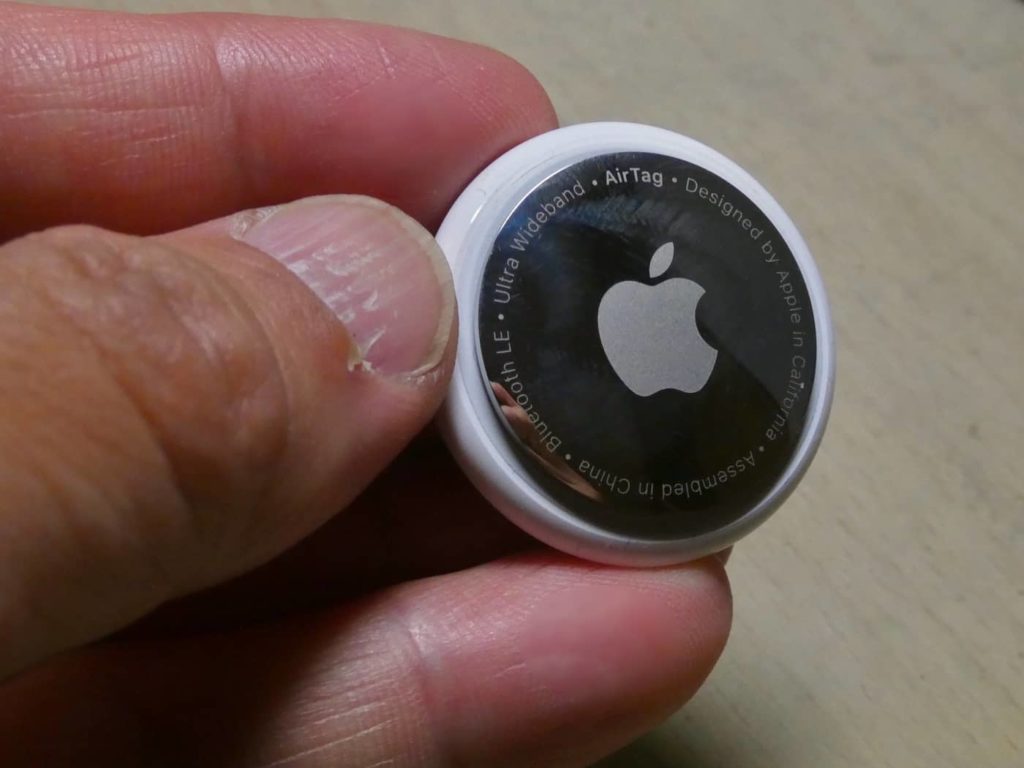The Apple AirTags joined the Apple tech ecosystem in April 2021. It was the family’s latest product. It’s a disc measuring one and a quarter inches that you can attach to your car keys, your wallet, or any other object whose location you want to track using other Apple devices. While on the surface, the AirTag looks like a practical and helpful little toy to have and never search for your missing car keys again, there are deeper security concerns about it. For example, a third party can use this gadget to track your movements.
Imagine you had something of a wild night. You wake up the following day; you’re at a friend’s place. That’s fine. You remember that. You get up, put on your jacket and get ready to leave. Then you feel something in your pocket. It’s not supposed to be there. You take it out, and you see an AirTag. It’s not yours. You’re not an Apple user. Your friend, an Apple fan, tells you that every AirTag he owns is accounted for. Since there is no other possible use for an AirTag than to track its location, you are suddenly not feeling very reassured. What should you do if something like this happens to you?
The first important thing to remember is: don’t panic. In this article, we will tell you everything you need to know about AirTags and how they work. Once you have that knowledge under your arm, you’ll understand the risks and how to deal with them.
What is an Apple AirTag?
AirTags are pocket-sized tracking devices that can interact with Apple devices. It’s about the size of a half-dollar coin. They’re light and easy to slip into almost anywhere without getting noticed. You can customize them with text or emojis, so they don’t get mixed up.
There are optional silicon and leather keyrings that can incorporate the AirTag, so you don’t have to dig around your purse or pockets to find it.
AirTags are Bluetooth devices that incorporate other types of ultra-wideband technology to broadcast location data associated with your Apple ID. The use case for these toys is to ensure that your keys, wallet, headphones, phone, purse, backpack, and similar objects or tablets never go missing again.
You can buy a single AirTag for 29 USD or four for 99 USD. The battery is good for more than 12 months, and you can replace it once it runs out. They are water resistant for about half an hour.
What makes AirTags tick?
The Apple iCloud includes the “Find My” network. AirTags send Bluetooth signals into that network, to which iPhones and other Apple devices are connected.
If you’re one of those owners of cool things that keep missing those cool things, you open the Find My app and locate your AirTag, or ask it to ping you. Then you can follow the app’s arrow or the tag’s sound until you find your piece of lost treasure attached to your AirTag.
In the newest iOS devices (iPhone 11 and later until the 13 with U1 chip), the AirTags can use ultra wideband tech. It allows locating the tag down to a centimeter of accuracy. So in plain English, your newer apple gadgets are very accurate at finding AirTags.
Older devices, the AirTags, need the Bluetooth of other nearby Apple devices. According to Apple, all these communications are encrypted so that no third party can read anything.
Android users can also take advantage of AirTag gadgets, but not by default –the default belongs to Apple users only. A handful of Android apps can interact with AirTags (AirGuard, Tracker DetectPro), which need installation before use.
Are Apple’s AirTags risky?
Here is what Apple has to say about these devices.
AirTag was designed to help people locate their personal belongings, not to track people or another person’s property, and we condemn in the strongest possible terms any malicious use of our products.
Mind you, misuse is “condemned,” not “prevented.” So unfortunate as it may be, the AirTags can be a tool for misbehavior, depending on the user’s intent.
The original point in AirTags was far from bringing new dangers into Apple users’ lives. Instead, the interaction system includes an alarm and end-to-end encryption to enhance security. But many faithful Apple users are complaining about the Cupertino giant not doing enough to make AirTags genuinely safe. But you, as a user, need to take security in your hands — that’s one of the major reasons why even Apple TV users keep turning to VPNs.
Consumer concerns
Do you know Brooks Nader? She’s a famous model of Sports Illustrated Swimsuit fame. She tells the story of having a stranger put an AirTag on his coat, stalking her around her town for hours.
And she’s not the only one. So many other persons report finding unwanted AirTags planted in their belongings without their knowledge. Given the nature of this gadget, the only possible purpose can be to track somebody’s movements. Car thieves are foremost on the authorities’ minds for this.
Keep your family and your property safe
There’s no doubt that the AirTags have a practical and useful application, which is to protect your property. Knowing where your things are is helpful in all kinds of circumstances. There is a report about a woman in New York who equipped her daughter’s sneakers with an AirTag. She found that the bus driver had taken her to the wrong school.
So the Apple AirTags are light, inconspicuous, self-powered, and valuable. They’re everything you want in a gadget to track your things… or on a spying tool. So the AirTags look and feel like coins, which is appropriate since they also have two sides.
Apple Airtags and privacy group warnings

As several stories in the press raised questions about AirTags (with our favorite swimsuit model at the top of the list), Apple released a Personal Safety User Guide. It tells people (not necessarily Apple users) how to protect themselves.
The guide includes an entire section on Apple AirTags that explains how you can figure out if there’s an unwanted AirTag around you, following you without your knowledge or consent. It covers both Android and iOS devices.
However, the group known as “STOP” claims that Apple is falling short. It released a report detailing the risks involving AirTags and other ultra-wideband tech devices. It calls the hardware in question “stalkerware” and says that no software upgrade can stop stalkers. That is something of a radical position on the AirTags, rare for Apple products which usually have great PR from all sides. However, construing the AirTag’s primary use case as stalking only is probably going too far.
Apple versus stalking
Apple has tackled the stalking potential on the AirTag with a feature that tells a user if an unknown AirTag is tracking them. You will get that notification as you arrive home (or within a day) on every Apple device configured with your AppleID. Moreover, Apple says that if you disregard the message or don’t find the invasive AirTag, it will start chiming after a day, so you know it’s around. It is an improvement over the three days it initially took for your phone to let you know about an unknown AirTag that’s been moving along with you.
Apple also says that the signals in their tags and in the “Find My” network rotate regularly and have unique identifiers. And that is supposed to prevent users from getting tracked as they move from one place to the next.
The AirTags in 2022: The updates we expect
Apple started to release updates to the AirTag’s functionality very quickly after their hit the market. However, users keep voicing their complaints about them. That’s why the community more or less expects new updates later this year that will address the following issues:
- Earlier notification. They will tell you about unwanted AirTags before the current window of 8 to 24 hours.
- Set up privacy warnings. The setup process will include new notices informing users that tracking another individual against their will is a crime in many countries.
- Louder sounds. The AirTags will become a bit noisier, so you can find them more easily.
- Additional precision finding. The precision finding is not available for unwanted AirTags yet, and this issue is supposed to be corrected.
- Specific gadget alerts. Air Pods will get a distinctive alert sound.
- Law enforcement documentation. Every AirTag has a unique serial number linked with a specific AppleID. Apple is supposedly willing to “provide the paired account details in response to a subpoena or valid request from law enforcement.”
An unwanted AirTag is following me! What do I do now?
Don’t panic. Just disable the unwanted AirTag. You can follow the prompts on your Apple device to learn more about disabling the device. The warnings and prompts will come from the Find My app. Here’s how you disable the unwanted tag:
- Click on the “AirTag Found Moving with You” warning on your device.
- Now click on “Continue.”
- If you can’t find the app, ask your device to make it “Play Sound.”
- Once you find the disk, tap it against your iPhone.
- Select “Instructions to disable AirTag” and follow through.
Once you’ve completed the above steps, the tag’s original owner can’t keep track of it anymore. So don’t throw away the AirTag. Instead, you will be able to tap it to find its serial number and other identifying data.
Scanning for AirTags with Android devices
Tracker Detect is an Android mobile app that hit the market in December 2021. It’s Apple’s, and it allows Android users to scan their environment for Apple AirTags they don’t want around them.
The app needs an NFC-enabled Android device (Near Field Communication) which is the protocol that enables two devices to communicate without physical contact if they’re very close indeed. NFC is the thing that allows precision finding.
How to scan for AirTags with Apple’s Tracker Detect on Android devices
- Find the Tracker Detect app in the Google Play Store. Install it.
- Enable your device’s Bluetooth.
- Launch the app.
- Tap on “Scan.”
- If the notification for an unknown AirTag shows, click on it.
- Choose among “Play Sound,” “Learn About this Item Tracker,” or “Instructions to Disable.”
- Tap “Play Sound” so you can find the tag more easily.
You can learn about the tag if you type “Learn About this Item Tracker” and tap the tag on your Android phone. It will enable the NFC precision finding. Also, you will be able to see the serial number and the owner’s phone number’s last few digits. If the tag is marked “Lost,” you’ll get a message explaining to you how to tell the owner you have the lost tag. If the tag is not lost, then you’ll have the “Instructions to disable” option so you can follow it and turn the thing off.
Using Apple’s AirTags
So the Apple AirTag has a dark side. Well, every tool has the potential for abuse. However, that’s no reason for you to avoid using it for legitimate purposes. On the contrary, AirTags are helpful gadgets that can make life easier for you and enhance your security. Moreover, now you know they exist, and how they work, you can use them properly. And here’s how you do that:
- Please turn on the following things on your iPhone or iPad: Find My app, Bluetooth, and Two-factor authentication.
- Connect to the internet. Either your mobile data or WiFi is OK.
- Place your AirTag next to your device.
- You’ll get the one-tap prompt on your screen. Follow through.
- Give your AirTag a name and tap “Continue.”
- Attach your newly enabled tag to that item you had in mind to protect.
Use Find My to find an item with an AirTag
Finding a lost item is the whole point of owning these neat little toys, so let’s see, al last, how you do that:
- Open Find My.
- Select “Items” at the bottom. Your AirTags will show up on the map.
- Tap an item’s name in the list to locate a particular tag.
- Use the “Play Sound” feature if you want to locate your tag in that fashion
- If you’re going to find the tag graphically, tap “Directions.”
- If, despite all your efforts, you still can’t find the AirTag, then select “Lost Mode” and “Enable.”
What makes AirTags stand out?
The tech media started to spill lots of ink (HTML, anyway) on AirTags as stalking tools as soon as they arrived on the market in April 2021. But unfortunately, many of the authors fail to acknowledge that stalking didn’t come about because of the Apple AirTags alone. A dedicated activist network has been active on this issue long before AirTags appeared.
For instance, there’s the National Network to End Domestic Violence. The group’s tech director, Erica Olsen, considers AirTags as a tiny element within a much larger problem. For instance, many years before 2021, there were cases of other little location trackers installed on the inside of teddy bears.
However, it would seem that the risk that AirTags create is different from everything we’ve seen before. The sheer high accuracy that the Find My network can achieve makes it different, among other reasons.
Another issue is as simple Apple’s logo. It would seem that the very presence of that symbol makes potential abusers less aware that they’re becoming criminals.
EndTab’s CEO, Adam Dodge, said,
It’s not a spy tool marketed as a spy tool because it’s marketed as an AirTag, and it’s Apple. People sometimes don’t think there’s anything wrong with it, apparently, and use it to track someone’s location because, to them, it’s a natural use of the technology.
EndTab is an educational institution that instructs about tech-enabled stalking and harassment.
Also, there’s something about the Apple Tag’s friendliness that makes people oversee what would otherwise be clearly intrusive behavior. For example, Mr. Dodge has a list of cases in which a well-meaning parent hides an AirTag in a child’s vehicle. But, then, there is an overall attitude, “yeah, so what’s the big deal? I wanted to know where he was.” Stalking is a big deal, of course.
And an even bigger deal is that most stalkers, as most killers and rapers, are not strangers, but current or former partners, family members, and other people with close ties to the victims. It’s all about power in human interactions.
Toxic power dynamics in friendships, families, or marriages are nothing new. But the Apple AirTags allow them to become magnified as never before.
So far, Apple’s only reaction to this situation is to warn users about the illegality of digital stalking. Unsurprisingly, a lot of people think this is far from enough. Yet, the correct solution isn’t apparent.
Final thoughts: Are the dangers of the Apple AirTag something to worry you?
In a word: No. You shouldn’t worry about the dangers of the Apple AirTags. Nor about any other kind of digital risk.
Don’t get us wrong, we don’t mean to say you shouldn’t care, but worrying will never help you. Instead, you need to be aware of the risks and be proactive about them. Prevention is way more effective in security issues than fixes. So, if you’re ready to face somebody else’s misbehavior with AirTags, you’ll always have the advantage. You need to be proactive here, as is the case for your iPhone and iPad security.
In the end, the Apple AirTags came to life to serve a valuable purpose for their users, and they do. However, the other side of the coin is not exclusive to them. Every digital technology creates security issues. However, you can’t go and live in a cave to remain unaffected. Instead, educate yourself. Know and understand the technologies you use, the risks they pose, and how to deal with them. That’s how you will achieve one of the most important goals our readers have in common: staying safe online.
FAQs
Yes, you can. However, this is a criminal activity in most countries unless you have the other person’s consent.
If an alien AirTrack remains close to you for more than eight hours, then your iPhone will notify you within 24 hours. Once you know that there’s an intruding tag near you, you can use the Find My app to find it and disable it.
Apple AirTags are meant to help you keep track of items you could misplace or lose.
As with most digital tools, AirTags are entirely safe as long as you’re using them according to their original purpose. However, being highly accurate tracking devices, they also have the potential to facilitate criminal activities such as stalking, car thieving, and other such things.






